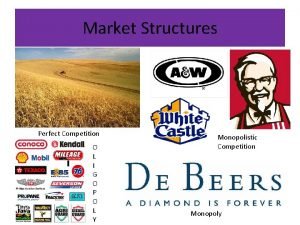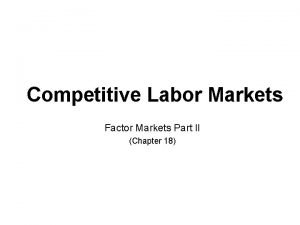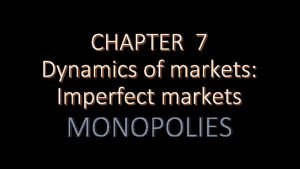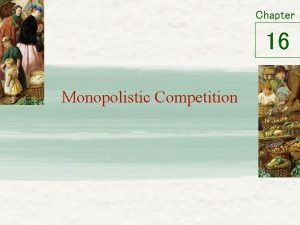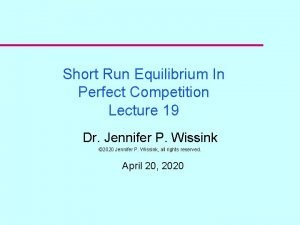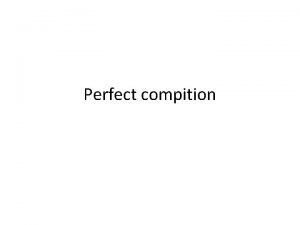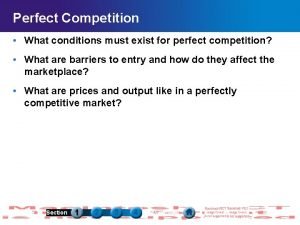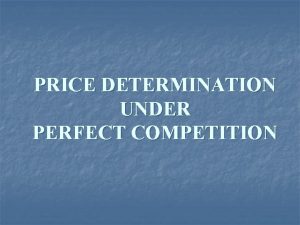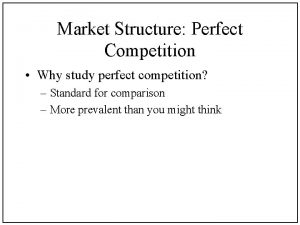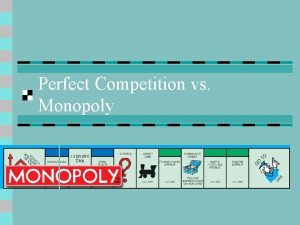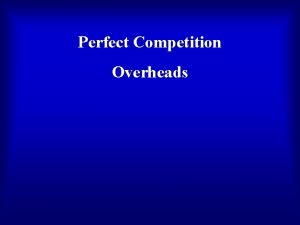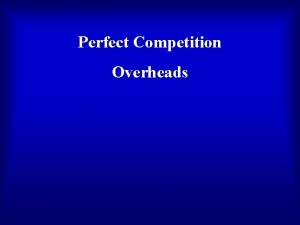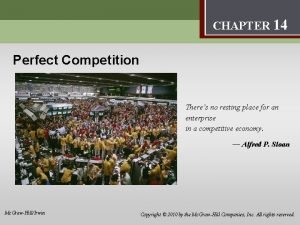Market Structure Types of market structure Perfect Competition
















- Slides: 16

Market Structure • Types of market structure: – Perfect Competition – Monopoly – Monopolistic Competition – Oligopoly • Discussions: – Characteristics of each market – Demand curve (AR) and MR – Profits-maximization rule – Short run and long run output decision

Perfectly competitive market Characteristics: • Large number of buyers and sellers in the market. Firms are price takers because the individual sales volume is relatively small compared to market volume. • Each firm/ seller or each buyer acts independently, rather than coordinating decisions collectively • Each firm produces a homogeneous (an identical) product: buyers cannot distinguish the product of one seller from that of another. • Perfect information about prices – The prices of all sellers are known – A consumer will purchase at the lowest price available in the market – No sale can be made at any higher price. • Free entry into and exit from market: Equal access to resources • Absence of promotion strategy and transport cost.

Demand (AR) and MR curve • Total revenue (TR) = P x Q • Average revenue (AR) = TR / Q = P • Marginal revenue (MR) = ΔTR / ΔQ P Q TR=P x Q AR= TR/Q MR= ΔTR/ ΔQ 10 10 10 1 2 3 10 20 30 10 10 10 P, AR, MR P = AR = MR 10 0 1 2 3 Kuantiti (Q)

Demand at the market and firm level under perfect competition Market (industry) Firm P P P = AR = MR D RM 10 D S RM 10 S D 0 1 2 Output 2000 Output

Equilibrium of a Firm • A firm is in equilibrium when it earns maximum profit or when minimum losses occur. • Equilibrium output = output level which gives the maximum profit to a firm. Profit maximization • Total revenue and total cost approach – Profit = TR – TC – Profit maximization: the highest vertical distance between TR and TC. • Marginal revenue and marginal cost approach – Profit maximization: MR = MC


Profit maximization under perfect competition • Short-run output decision: MR = MC – P > AC firm earns economic profits/abnormal profit – P = AC zero economic profits/ normal profit – P < AC firm suffers economic losses – P < AC but P ≥ AVC loss by operating, but this loss < FC – P < AVC shut down • Long-run output decision

Short-run output decision • P > AC • P = AC Price & costs MC MC AC AC A P 1 AR=MR=P=DD P 2 B 0 Q P A 0 Q Output (Q) TR = 0 QAP 1 TR = 0 PAQ TC = 0 QBP 2 TC = 0 PAQ Profit = TR – TC = P 1 ABP 2 Profit =TR –TC = 0 AR=MR=P=DD Output (Q)

Firm incurs a loss • P < AC but P > AVC P < AC – a loss Harga & kos MC AC A P 2 P 1 B 0 Q AR=MR=P C 1 A AVC P B AR=MR=P C 2 E output TR = 0 QBP 1 TC = 0 QAP 2 TR < TC, firm incurs a loss = P 1 BAP 2 This firm can reduce cost by using a better technology to obtain normal profit. AC shifts downwards. 0 Q output TR = 0 PBQ = 0 C 2 EQ + C 2 EBP TC = 0 C 1 AQ = 0 C 2 EQ + C 2 EAC 1 The firm incurs a loss, but TR > VC or AR > AVC

MC and short-run supply curve for a competitive firm Price M P 3 AC AVC L P 2 K P 1 Po MC J Qo Q 1 Q 2 Q 3 MC curve at points JKLM = a firm’s SS curve Output

Long-run competitive equilibrium • Free entry into and exit from market: if profits were +ve, entry would occur and P would fall. If profits were –ve, exit would occur and P would rise. Ultimately P = AC, all firms in the market earn zero economic profits/ normal profit. P = MR= MC, P = minimum AC. Harga & kos LMC SAC AR=MR=P P 0 LAC Q Output

Calculation approach: 1. The cost function for a firm is given by C = 5 + Q 2 If the firm sells output in a perfectly competitive market and other firms in the industry sell output at a price of RM 20, what price should the manager of this firm put on the product? What level of output should be produced to maximize profits? How much profits will be earned?

Answer: - The manager should price the product at RM 20 - Profit-maximizing output: MC = P. MC = 2 Q = 20, Q = 10 - Profits = TR – TC = Px. Q – (5 + Q 2) = 10(20) – 5 – 100 = RM 95

2. Suppose the cost function for a firm is given by C = 100 + Q 2. If the firm sells output in a perfectly competitive market and other firms in the industry sell output at a price of RM 10, what level of output should the firm produce to maximize profits or minimize losses? What will be the level of profits or losses if the firm makes the optimal decision?

Answer: P = RM 10, MC = 2 Q. Profit maximizing output: P = MC, 10 = 2 Q, Q = 5 units. Profit = TR – TC =10(5) – 100 – 52 = 50 – 100 – 25 = -RM 75 The firm incurs a loss of RM 75, which is less than the loss of RM 100 (fixed costs) that would result if the firm shut down its plant in the short run.

3. A vegetable seller faces a horizontal demand curve. Total variable costs are given by TVC=150 Q – 20 Q 2 + Q 3. At what price should the firm shut down? Solution: Shut down point occurs when AVC is at the minimum point. It also happens when P=MR=MC=AVC. Derive TVC to obtain MC. MC = d. TVC/d. Q = 150 – 40 Q +3 Q 2 Divide TVC by Q to obtain AVC: AVC = TVC/Q = 150 – 20 Q + Q 2 To find shut down price, set MC = AVC: 150 – 40 Q + 3 Q 2 = 150 – 20 Q + Q 2 2 Q 2 – 20 Q = 0, 2 Q(Q - 10) = 0 Q = 0 or Q = 10 Substitute Q = 10 into the MC equation to obtain P P = MC = 150 – 40(10) + 3(10)2 = 50 Shut down price is RM 50.
 Monopoly vs perfect competition
Monopoly vs perfect competition Perfect competition vs monopolistic competition
Perfect competition vs monopolistic competition Competition refers to
Competition refers to Difference between monopoly and perfect competition
Difference between monopoly and perfect competition Factor market perfect competition
Factor market perfect competition Difference between monopoly and perfect competition
Difference between monopoly and perfect competition Difference between perfect competition and monopoly
Difference between perfect competition and monopoly Perfect competion examples
Perfect competion examples Monopoly vs oligopoly venn diagram
Monopoly vs oligopoly venn diagram Pure competition companies
Pure competition companies Perfect tenses
Perfect tenses Perfect competition side by side graphs
Perfect competition side by side graphs Short run and long run equilibrium in perfect competition
Short run and long run equilibrium in perfect competition Short run graph
Short run graph Shutdown point
Shutdown point Monopoly conditions
Monopoly conditions Long run market supply curve
Long run market supply curve



